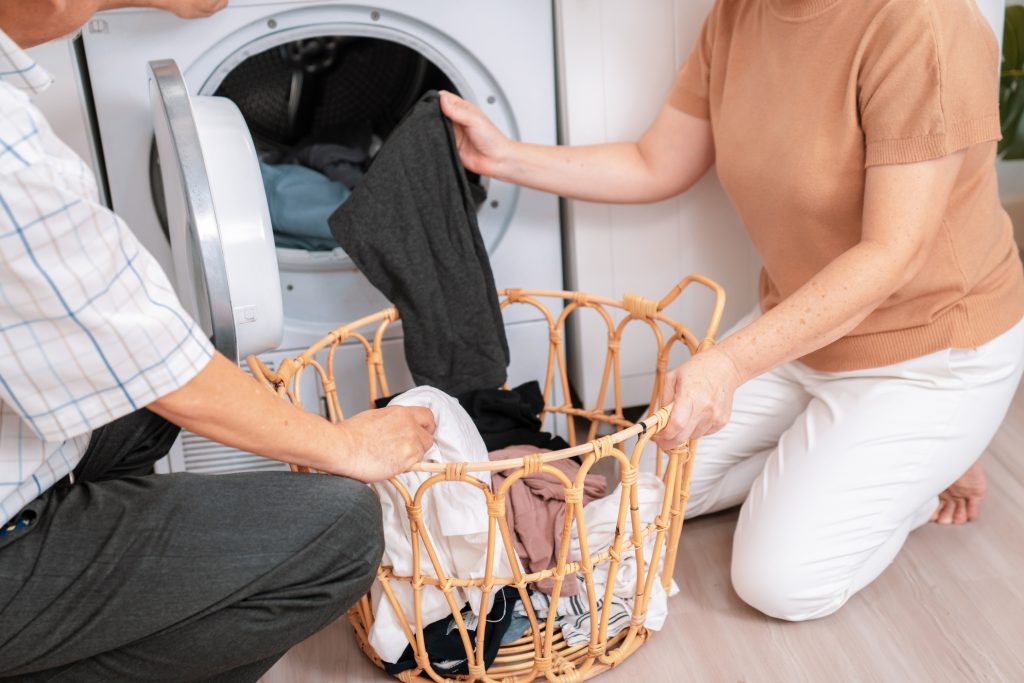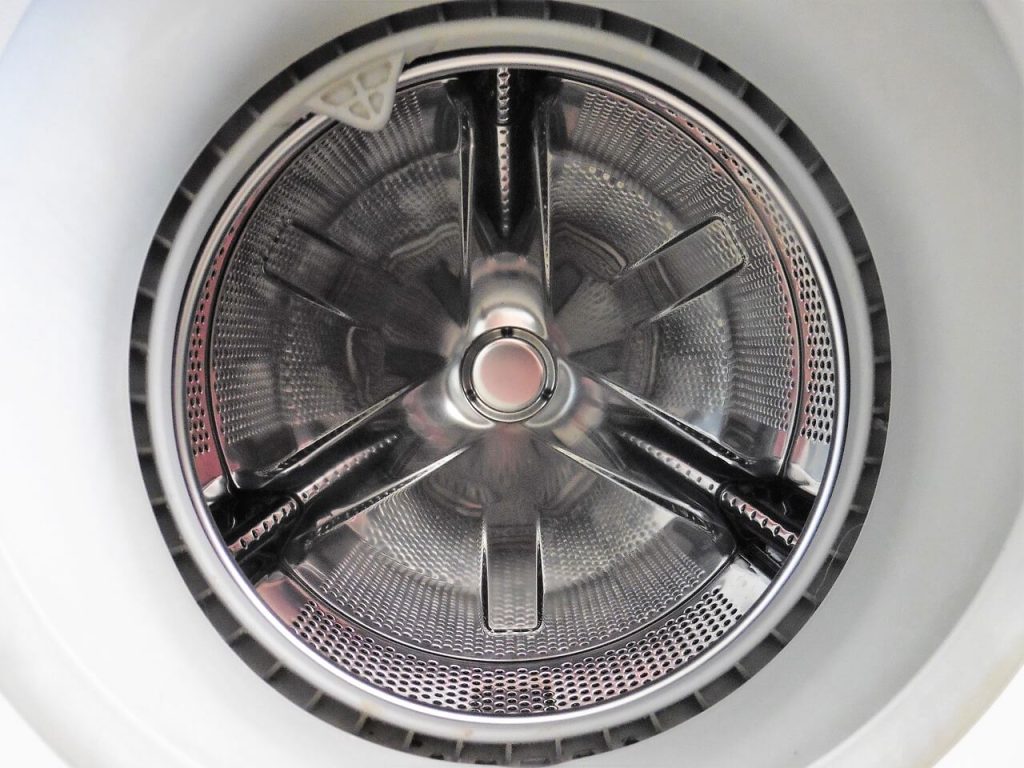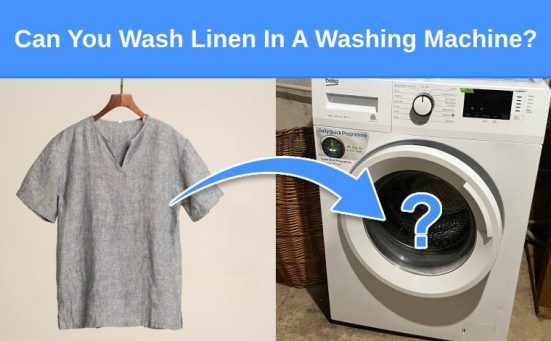
Washing Machine Leaking From The Drum? (here’s why & what to do)
If you notice water leaking from the front of your washing machine around the door area or a puddle directly under the door of the machine, it usually means your machine has a leak.
This could be caused by the rubber door seal (gasket) which has become damaged or misplaced, a hose is leaking, the tub is leaking or the door hinges or latch have become misaligned. Another common cause is overloading the drum.
I recommend regularly checking for water lines, puddles or areas of dampness underneath or around the door area of your washing machine. This way you can spot any possible leaks quickly and deal with them before they become a problem.
What Causes The Washer To Leak Around The Door?

The first step to fixing the problem is finding out exactly where it is. If you notice water leaking from the front of your washing machine, it could be caused by any of the following;
Overloaded Drum
If you regularly cram as much laundry as you can into the drum of your washer, not only will it not clean properly, you could be causing damage. Overloading the drum means it is constantly turning whilst carrying too much weight.
This can lead to undue pressure being placed on a particular area which could eventually cause it to leak. Plus overloading the drum can cause it to become unbalanced. This could lead to the drum becoming dislodged inside the washer causing water to leak out.
You should never fill the washer to more than ¾ of its capacity.
The Rubber Door Seal (gasket) Damaged

The rubber gasket or seal that runs around the door of your washing machine is designed to prevent any leaks. Over time, the rubber can become worn or start to perish which will allow water to pass through it.
You need to inspect the rubber seal and if it looks worn or frayed or damaged in any way, it will need to be replaced. This can be done by a competent DIYer but if you think this is a step too far for you, contact a technician to do it for you.
If you do want to replace the seal yourself, just follow our step by step guide;
- Disconnect The Power Supply
Remove the plug from the wall socket or flip the circuit breaker to the off position. - Remove The Front Panel
You will need to consult your user manual for specific instructions but you will need to remove the retaining screws holding the front panel in place. If your appliance doesn’t have a removable front panel, you will need to remove the top of the washer to gain access to the door seal. - Remove The Outer Retaining Band On The Seal
Washing machine door seals are typically fitted with a plastic retaining spring or band that will need to be removed before you can remove the seal. To remove the retaining band you should pry it away from the rim and pull it off the seal. If you’re lucky, your model may not have a retaining band (this will make the job easier). - Fold The Door Seal Into The machine
Using the least amount of pressure that you can, gently fold the rubber seal from the edge of the drum using a flat headed screwdriver or your fingertips. This allows you to access the inner retaining spring or band around the drum. You might find some clips holding the band in place, you can remove these using the screwdriver to remove the screws holding them. Then prise the clips free using the screwdriver. - Remove The Retaining Band
You will need to locate the screw that is holding the band in place and remove it. Then prise the retaining band free from the drum. - Take Note Of The Drain Holes Position
Before removing the rubber door seal, take a note of where the drain holes are positioned. The replacement seal will have similar holes that will need to be aligned in the same place. - Remove The Seal
Once the retaining band has been removed, the seal should be easy to remove. But in some cases, the seal could be stiff and difficult to remove. Take care as you pull the seal from the machine as it may be stuck. - Clean The Drum
Wipe away any dirt or grime from around the drum and inside of the washer door. - Lubricate The Seal
Check the new seal, because some come already lubricated, if not, use washing up liquid as a lubricant to ease the fitting of the seal. - Place The New Seal Over The Drum
Make sure the drain holes are aligned with the holes in the door of the washer. - Install The Inner Band Onto The Rim
This can be difficult because the spring or band could be really tight. You may find it easier to place the tightening screw in position at the top of the rim and gently inch the rest onto the lip using a flat head screwdriver. - Fit The Door Seal
Unfold the seal and fit it onto the outside of the drum and refit the retaining band to hold it in place. - Assemble The Rest Of The Appliance
It’s now time to replace the top, front panel or door (if it was removed). - Check For Leaks
Run a short wash cycle and check all around for any leaks.
A Leaking Hose
As the machine ages, certain components can become damaged and this includes the hoses on your machine. The inlet hose is under constant pressure from water entering the appliance which is held in check by the inlet valve.
If the inlet hose develops a leak, it could cause water to leak around the front or door area of the appliance. The same is true if the drain hose develops a leak.
You will need to move the washer from under any cupboard space so you can access it all round. Then run a short wash cycle and check where any water is leaking from. If it does prove to be coming from one of the hoses, it will need to be replaced.
Sometimes, the hoses aren’t damaged, they have simply become loose. If the water is leaking from the top or bottom of the hose around the spot where the hose joins the washer, you may just need to tighten the clamp holding the hose in place.
Door Hinges Or Latch Misaligned
In some cases, the door hinge or door latch can become slightly misaligned. This will cause the door seal to not function correctly and result in water leaking from the front or door of the appliance.
Unless you know what you’re doing, I recommend getting a technician to check and fix this issue for you.
Detergent Dispenser Leaking

Over time, the detergent dispenser drawer can become clogged with dried detergent or fabric softener, limescale or mould. Or the hose connected to the dispenser drawer can develop a leak.
If the dispenser drawer is particularly messy, it will need to be cleaned thoroughly to remove any offending objects. Remove the drawer and soak it in a 50/50 solution of white vinegar and hot water for around 30 minutes.
Then scrub the drawer using a soft bristled brush (like a toothbrush). Make sure to clean inside the drawer housing as well using a cloth soaked in the white vinegar/hot water solution.
To clear a blocked tube, pour 1 cup of bicarbonate of soda into the drawer housing and then spray with white vinegar. The foaming reaction will drain into the tube and remove any blockage.
If the hose is leaking, I recommend contacting a technician to solve this for you as you will need to dismantle parts of the appliance to access the area.
Defective Drain Pump
Sometimes, a leak at the front of the washer could be caused by a defective drain pump. This is definitely a job best left to a technician to check.
The Tub Is Damaged
If you’ve checked everything else, all that’s left is a cracked tub. The tub is a sealed unit and cannot be accessed without difficulty.
It is also an expensive part, your technician will be able to advise you on whether it’s better to replace the tub or buy a new appliance.
Is It Worth Repairing A Leaking Washing Machine?

Whether it’s worth repairing a leaking washing machine depends on how old the appliance is and how much the repair will cost. The average lifespan of a washing machine is around 10 years give or take.
If your washer is 5 years old or less and the repair will cost no more than half the cost of a replacement machine, it’s worth doing. However, if the machine is more than 6 years old, and the repair will cost more than half the cost of a replacement, you might decide your money is better spent on a new appliance.
SEE ALSO: Washing Machine Leaking From Underneath? (here’s why & what to do)
Frequently Asked Questions
If your washing machine is leaking, it needs to be repaired or replaced. Allowing a washing machine to leak can cause serious damage to your home. Whether the machine should be repaired or replaced however, depends on how old the appliance is and how much the repair will cost.
If your washing machine is leaking from the door it could be because; the drum is overloaded, the door seal is damaged and needs replacing, the detergent dispenser drawer is leaking or one of the hoses is leaking.
If water is coming out of the bottom of your washing machine it is likely to be because; one of the hoses is loose or damaged, the drain pump is defective, the door seal is defective, the tub is damaged or the drum is overloaded.




